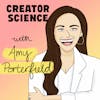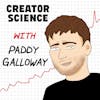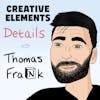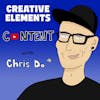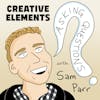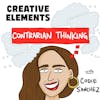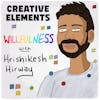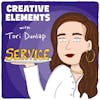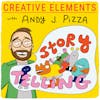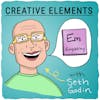
#97: Dickie Bush Returns! – Jumping ship from full-time job to full-time creator
Play EpisodeDickie Bush is the creator of Ship 30 for 30, a cohort-based course and community of people developing a writing habit in 30 days
Dickie Bush is the creator of Ship 30 for 30, a cohort-based course and community of people developing a writing habit in 30 days.
He is passionate about providing writers and creators with the tools, resources, processes, and mindsets required to find points of leverage and achieve exponential growth—both personally and professionally.
Since our first interview, Dickie has grown his Twitter following from 10,000 to more than 175,000 at the time of publishing. He's also now served 4,000 students through Ship 30 for 30.
In this episode, we talk about Dickie’s wild year of growth, the evolution of the Ship 30 for 30 student experience, Dickie’s underrated growth technique, and why adding his new software product Typeshare is adding to their business Flywheel.
Join the Creative Companion Club 🤫
Follow Creative Elements on Instagram
Full transcript and show notes
***
SPONSORS
***
IF YOU LOVE CREATIVE ELEMENTS
Subscribe to weekly episode emails
Leave a review on Apple Podcasts
***
ABOUT JAY CLOUSE
Subscribe to my newsletter, Creative Companion
***
FOR PODCASTERS
Enroll in my podcasting workshop
Enroll in my course on podcasting, Podcast Like The Pros
***
PODGLOMERATE NETWORK
This show is a part of the Podglomerate network, a company that produces, distributes, and monetizes podcasts. We encourage you to visit the website and sign up for our newsletter for more information about our shows, launches, and events. For more information on how The Podglomerate treats data, please see our Privacy Policy.
Since you're listening to Creative Elements, we'd like to suggest you also try other Podglomerate shows surrounding entrepreneurship, business, and careers like Rocketship.fm and Freelance to Founder.
Learn more about your ad choices. Visit megaphone.fm/adchoices
Dickie Bush 00:00
You know, if you were going to the gym, and I said, yeah, let's just start working out and I'll tell you when it's over, you'd probably run right out of that gym. Like you can me, you're gonna put me on this treadmill and not tell me when it's going to be over or when I can take a break or if I'm doing the right thing. And I think a lot of courses potentially do that, where they know the outcome they're trying to create for a student, but they don't communicate it well.
Jay Clouse 00:23
Welcome to Creative elements, a show where we talk to your favorite creators and learn what it takes to make a living from your art and creativity. I'm your host, Jay Clouse. Let's start the show. Hello, my friend, welcome back to another episode of Creative Elements. We have a big one today. But hey, first, I wanted to give a quick plug to my newsletter, Creative Companion. I write a new article every week to help you become a professional creator. It's free. It's delivered on Sunday mornings, and I think you'd really enjoy it. You'll also get an email each week with a behind the scenes story about that week's episode of Creative Elements and that guest. More than 10,000 people already subscribe. So if you aren't already subscribed, I really think you should be, just visit creativecompanion.club or click the link in the show notes. That's creativecompanion.club. And speaking of creativecompanion.club, thank you to everyone who reached out about last week's announcement about my new membership, the Creative Companion Club, we got a couple new members, we have such an excellent community of creators coming together and I'm having such a blast hanging out and supporting the folks in there. If you're serious about becoming a professional creator, I would love for you to join us. We have live events each week including office hours and member one on one hot seats led by me, which means all have the opportunity to support you one to one. More information on that is in the show notes as well or you can visit joinccc.com. I am pumped about today's episode. Just about a year ago on episode number 51 of the show, I interviewed Dickey Busch, the founder of Ship 30 for 30. A 30 Day cohort based course to help people start writing online. Through the Ship 30 experienced, students write and ship 30 pieces of writing in just 30 days. In Dickie's team, including his business partner, Nicolas Cole have big plans for Ship 30.
Dickie Bush 02:35
We want to help a million people start writing online. And we'll never say that Ship 30 is an audience building course, or anything like that, because I think an audience is a byproduct of high quality writing. And so we'd rather talk about hey, what are the things that if you just show up and do these, an audience, it's a byproduct and not something you're optimizing for, and that's writing high quality stuff. Shipping consistently, figuring out what the markets actually looking for.
Jay Clouse 03:02
The Ship 30 for 30 course is pretty legendary, at least in certain corners of the internet. It's hard to be on Twitter and not have come across one of his students sharing what Dickie calls atomic essays, short single ideas expressed in 250 words or less. I love his team's focus on the inputs of his students. They will help you create high quality writing and as a result, other goals like audience growth are a byproduct. At the time of our first interview, Dickie himself had grown to 10,000 followers on Twitter, up from just about 600 followers a few months before, we focused a lot on Dickie's approach to Twitter that helped him with that initial growth. And if you haven't already listened to that first episode. I just re-aired it yesterday. So it might be a good idea to take a listen to that one first. Today, Dickie has 175,000 followers on Twitter. And again, it's only been a year.
Dickie Bush 03:56
The last year has been a quite a journey. And I look back as it was what late February 2021 when we first recorded so yeah, I'm sure we'll dig into everything that's kind of happened between now and then but has been quite a ride.
Jay Clouse 04:11
The Ship 30 team has now helped about 4000 students through their course and at a price tag of 499 to 799 per student depending on how early they enroll. That's a significant business somewhere between $1 million and $3 million in revenue from Ship 30 students alone. But the team has been building experiences beyond Ship 30 too, including their new alumni community, the captain's table, at a current price point of just under $1,500 per year. These numbers are super impressive and they add up fast. And up until a few weeks ago, Dickie was still working full time at BlackRock, one of the leading investment firms in the world. We talked about the decision to leave his job later in the interview, but it wasn't an easy decision for Dickie to make.
Dickie Bush 04:55
What really settled me on making this decision was a core framework I used to make a lot of decisions which is how would the person I'm trying to become make this decision and what decision would they make? And that was slapped me in the face obvious by the end of you got to go bet on yourself and and take this leap on your own. So that's what happened.
Jay Clouse 05:18
So in this episode we talk about Dickie's wild year of growth, the evolution of the Ship 30 for 30 student experience, Dickie's underrated growth technique, and why his new software product, Typeshare is adding to their business flywheel. I'd love to hear your thoughts on this episode. As you listen, you can find me on Twitter @jayclouse or on Instagram @creativeelements.fm, tag me, say hello, let me know that you're listening. Oh, and by the way, the next student cohort of Ship 30 for 30 is beginning on April 18th, Dickie was kind enough to let me be an affiliate for the course. So if you enroll through creativeelements.fm/ship30, you'll also be supporting this show. That link is in the show notes. Okay, that's enough of me. Let's get this fantastic conversation with Dickie Bush.
Dickie Bush 06:11
Last year has been awesome. But I do want to start with saying, you know, the quality and effort you put into these episodes is really second to none. So the images, the editing, everything, it just steps above other podcasts. So I really appreciate you having me back on.
Jay Clouse 06:25
Thanks, man. I remember, there's actually a moment where I was really down on myself. Because when we chatted, I you know, I do like research and have this document before we talk about the current state of things. And you had about 10,000 followers on Twitter when we chatted. By the time I was actually editing the episode and publishing it. I had to say in the intro, since we recorded this, Dickie has actually doubled his following to 20,000 followers. Dickie himself has built his Twitter following from near 0 in August 2020 to over 10,000 at the time of this interview, to now nearly 21,000 at the time of this recording. And at the time, I was like what the hell am I even doing? This guy is just like blowing up. What am I doing this not what he's doing? And we sit here today recording this 173,000 followers, who knows what'll be when I have to publish it?
Dickie Bush 07:19
Well, it's funny you say that because I had a very similar feeling when we were originally getting together to record. So I don't know if you remember this. But the Wednesday we were supposed to record. You gave me a call or I think you sent me a loom video that was saying, hey, Dickie, you know, this has come up this, all these things have come up. I need to reschedule and it wasn't reschedule and here's a better date. It was just I don't know when I'm going to be able to reschedule. And so the way I interpreted that was, I remember when you asked me to be on the podcast, I went and looked at some of your former guests. And it was the James Clear's, the Tim Urban's people that I just looked up to these kind of monumental figures. And I remember when you sent me that loom video, the story I told myself was, I knew that was coming. He he figured out I was fraud, that he wanted nothing to do with me on the podcast to hear from me versus all these other legends he's had. And I remember like that day kind of being bummed out. But then you called me a week later, and you said, hey, you know, let's get back on and we'll do it this day. And I remember almost being extremely relieved because, one it turned out to be such an awesome episode, but two it kind of cured some of my imposter syndrome a little bit back then.
Jay Clouse 08:36
Wow. Okay, well, I'm gonna insert the audio from the video here. Hey, Dickie, I wanna shoot a quick message here. I'm having one of those days where everything is going like hilariously wrong and badly. And I'm not in a great space mentally to do an interview. Hate to reschedule, I almost never reschedule. I've already pushed you back once so no hard feelings if you feel like I'm yanking your chain. You don't want to do this. But I am very much looking forward to it. And I have a lot of questions that I want to ask with you. And I think we can make a really great episode but have to move back from today, unfortunately, and I am sorry, sorry, sorry that that is the case. I didn't remember that recorded video. I'm actually going back into our DMS right now. And looking at this, I remember the circumstance, it was February 5th 2021, we first scheduled the interview. February 24th, I sent this video saying I needed a punt which is like the second time we had to punt. And I'm so glad you're using the language the story I told myself because that's just like really powerful language for anyone to take away from this when you're trying to talk to somebody because it removes any feeling of like, blame like, you did this. You made me feel this way. It's the story I was telling myself was because the story I was telling myself when I said hey, I need to punt if I haven't put you off too much, I would love to reschedule. Story I was telling myself was this guy is probably sick of me rescheduling and probably doesn't want to do the interview anymore.
Dickie Bush 10:03
I think that language of the story that I'm telling myself is one of the biggest lessons I've learned in the last year, I started saying it, because everything is the story we're telling ourselves. And so instead of interpreting something someone says, or the way you're acting, it's all a story we're telling ourselves. So the more you can separate that from what's actually happening, you're able to, I think, make more rational decisions, live a calmer life, it's definitely been an upgrade.
Jay Clouse 10:31
Do you remember where you found that? Because I found that too. And it's, it's been a big part of how I communicate with my fiance, actually, when we're having any type of conflict. I say like, well, the story I'm telling myself right now is.
Dickie Bush 10:42
I think it's from Nonviolent Communication, the book, but I think it was relayed to me from a Tim Ferriss episode, where he said he had it with his fiance, yeah.
Jay Clouse 10:53
Yep, yep. I think that's, I think that's the the origin for me as well, which makes sense, since it has become like the way that I communicate in relationship wild. Well, I'm glad we made it happen. I'm glad we did it when we did, because looking at your social blade graph of just Twitter in particular over that next year, it's wild. It's crazy. So we talked about feedback loops in that first episode, and how you were intentionally approaching Twitter at the time, not in like a formulaic way, but in like a rigorous way. How did that approach follow through throughout last year, you know, from February and beyond?
Dickie Bush 11:32
So last year, we were late February had about 9000 followers. And I built that primarily through kind of exploring various interest, I hadn't really doubled down on anything, we were in the very early stages of Ship 30. That was, I think we had about 300 students total at the time. Now we're coming in over 4000 over the last year. So my approach didn't change very much, I still approached it with kind of a scientific of I'm going to put out a lot of ideas, see which ones resonate, see which frameworks are working double down on those. And it's the foundation of what we teach in Ship 30 is, you don't really know what's going to work until you start to put those ideas out there. And by the time we talked, I had a decent idea of what was going to start working, it was all execution risk at that point. It was all I just needed to actually show up every day for the next year. And that's the spot you want to be when you're creating is the in the very beginning, it's I actually don't know what it is I want to talk about at all so I should get out there and start sharing a bunch of ideas. But things really start to click when you understand the things to double down on and have a good sense that they're going to work that is the sweet spot to operate, where you're writing things that you know people are looking to read, the market is begging for you to put them out there. And then you just get the wake up and deliver to them.
Jay Clouse 12:54
I've started using this language, creative commitments, haven't really socialized it yet. But when I think about my own creative commitments, it's like I need to publish a newsletter on Sunday, I'm going to publish an episode of the podcast on Tuesday. And that's as far as I go with like a no negotiating, these are the commitments I make to people every single week. Do you have creative commitments like that? And if so, what are they?
Dickie Bush 13:16
I don't, but maybe implicitly I do. I know, I haven't said I have to publish a thread a week or a tweet a day or anything like that. I've been operating more of, I know, I'm going to put out a good amount of content and I'm going to write a lot of stuff. And so less, a minimum bar just keeps showing up. I know that I know that by the end of the week, I should publish X, Y and Z. But I haven't been tracking anything specifically other than I know that the way to keep growing and the way to keep having success is to continue to create. And so just focusing on not stopping. That's really my creative commitment is that I don't publish nothing.
Jay Clouse 13:58
That's so interesting, because I can't put myself in that mindset because I wouldn't know when I ship. So how, what what is the trigger for you then?
Dickie Bush 14:05
Well, I do sit down on usually Mondays and try to write for as long as I can. That's usually when I do. I'm writing every day. But I feel I get the most out of just almost binge writing sessions, or I write a bunch of ideas and I kind of create this throughout the week I'm capturing, capturing, capturing. And then Monday morning, I sit down and I go through that list. And I know the ideas I'm going to jump to, I know the ideas that have almost built up this creative energy in me and then I just go to town, I block everything off and try to write for as long as I can. And then I know that I have enough to go for a week or two weeks or whatever, without the forcing of I got to get up and write something and publish it, right, trying to stay ahead of the curve. What happens is when I have so much to share, I just want to share it, right, so the consistency takes care of itself because I build up a buffer and I just know that, oh, I got to get this idea out there tomorrow, because I'm excited to see what people think about it.
Jay Clouse 15:05
In your modalities, you have just a plain tweet, you have threads, you have newsletters that are coming out from you now, are there other modalities or like types of content you're creating?
Dickie Bush 15:17
Atomic essays are in there to when I want to get a little bit of expansion on an idea, but don't necessarily need a whole thread or I It's longer than a tweet. But that's usually how I think about it with tweets, atomic essays, threads, and now the newsletter, which is kind of our way to create longer form content that digs into things, delivers a lot of value to our list, and we end up taking those and putting them on the Ship 30 blog as well. So that's our new longer form medium, where we know that, hey, this idea needs 10,000 words, we get to really flesh this thing out, let's put it somewhere where someone can bookmark it and download it and all that.
Jay Clouse 15:55
So throughout the week, you're documenting and capturing ideas that you're having, then you have these binge writing sessions. Talk to me about how you parse through those ideas and decide or like categorize to say, this is a thread, this is atomic essay, this is going on the blog, is it just all gut feel or do you have some sort of processor system?
Dickie Bush 16:15
It's all got feel right now, where I've just done it long enough with, hey, I don't think that this well, it goes back to kind of the way I think about content in general, where everything you should optimize for either reach or resonance. Reach content is things that I think can go viral, threads breaking down, famous writing routines, you know, life frameworks, things that the total addressable market of readers is huge. Those, I want to optimize for virality and that's probably a thread. The opposite is resonance content, which is I want to write for one specific person to deliver some kind of outcome. By definition, I'm going to cut out a huge number of readers with my specificity, right? If we write a long form newsletter post on how to write an effective CTA, for your Twitter threads, right, this is, this is a niche market. But I know that people who read it are far more likely to find value from it and build trust in me to deliver that value. So the difference between region resonance content is people have read a bunch of my viral threads and not associated any kind of trust or credibility with me, it's just a hey, this was interesting, right? But resonance content, when you solve someone's specific problem, they immediately see you as a trusted source to deliver more helpful content. So I usually break it down to hey, am I is this an idea that I think could go viral? Or is this something I want to write to one person to achieve one outcome? And that usually breaks down the difference.
Jay Clouse 17:49
As you've grown your total Twitter following, and you've had some of these viral a lot of these viral threads that reach a mass audience, and you start to create these more deeper resonance posts. My understanding of how social media algorithms work is they take thing you post, they share it to a small number of your followers. And if it does, well with that group, they start showing it to more of your followers, and then maybe even beyond your followers. So if you have this big pool that they can pull that small sample from, and a lot of those people might have been like the more viral, more accessible content. Is it hard sometimes for those more resonant, more specific posts to catch legs?
Dickie Bush 18:27
Probably. But that's the point of resonance content is that it doesn't need to find legs. The people who are going to find the most value from it will stumble upon it because they already see me as a trusted source. If that makes sense there. They might have notifications on for my tweets, right? So those are the kind of people I'm writing that stuff to, right, they're subscribe to our newsletter, where I know that I'm not really sharing resonance content as a on Twitter as much as we are on the newsletter or directly within the Ship 30 community, things like that. Whereas social media, I know it's more optimized for that reach content.
Jay Clouse 19:06
After a quick break, Dickie and I talk about the metrics his team tracks at Ship 30, how they've improved the Ship 30 student experience, and one of the biggest secrets to Twitter growth. And later, we talk about other social media platforms and why Dickie decided to leave his job to focus on Ship 30 full time. So stick around and we'll be right back. Welcome back to my conversation with the creator of Ship 30 for 30, Dickie Bush. In our first interview, Dickie and I talked about feedback loops. Today, Dickie said he's focused on flywheel effects. It's pretty clear to me that given his background in finance, Dickie is pretty data driven. So I asked him what kinds of metrics he and his team track.
Dickie Bush 19:47
So within Ship 30, it's number of people we've helped start writing online. You know, the core mission is to get to a million people, and we're at 4000, which is not as high as about 4% so we got a lot of ways to go. That to me is the number one metric because it informs everything else, right? If I'm creating helpful things that help people start their creative journey, I know I'm headed in the right direction. That is the number one metric. The byproduct of that is newsletter subscribers or Twitter following. But I think those are vanity metrics for the most part that I've, I'm not optimizing for in any way. I think they're a byproduct of one clarity of my writing or the ideas that I share or things like that, that take care of themselves. So I tried to focus on density metrics, right, things that show what I'm doing is resonating with people versus just reaching a lot of them.
Jay Clouse 20:36
This is so interesting. Okay, I think maybe just a couple more questions on Twitter, and then we can move on to other things. But while we're on the subject, threads obviously, go viral. And that seems to get a lot of followers. Are there any other aspects of Twitter growth that people aren't talking about as much as threads?
Dickie Bush 20:52
Not really. And I think I tweeted this out the other day of here's your $500 Twitter course in three bullet points, write a tweet every day, right, one thread every week, and make friends with other people in your niche. And no one really wants to do that for 52 weeks, and no one wants to hear that. It's that easy. People love complexity and I think complexity sells. When you say hey, I get this complex system, it's going to do X, Y and Z. But you couldn't sell those three bullet points for 500 bucks. And that's why they work.
Jay Clouse 21:22
Let's talk about that last point, the friends point, what does it mean to make friends with other people in your niche? And what does that look like for you?
Dickie Bush 21:28
Making friends with other people in your niche is one the most underrated way to grow. The most underrated way to really enjoy what you're doing for the long haul. Because what else are we doing this for? The fact that the internet has democratized access to friendship, meaning for your entire life growing up before the internet, if the people on your street or the people you grew up with, or the people at your school didn't like the same things as you, you are kind of out of luck. But with the internet, for better or worse, you're able to find them very easily, and become friends with them instantly, via Twitter DM just by putting yourself out there. So to me, it's what is the point of doing this other than to find other people interested in the same things as you because that is the richness of a relationship that you can form, it's, hey, I had no clue where you're from, what your background is, but we like these same things, let's be friends. And the byproduct of that is you just find people to grow together with. And that is the best part of the journey in and of itself when you can look back and just like we did what we can look back on this interview from a year ago and say, wow, look at that, you know, you create these milestones. So I think that's the number one thing you should optimize for is, hey, how do I put things out there that are going to attract the type of people that I want to be friends with? And then how do I easily become friends with them?
Jay Clouse 22:47
Yeah, I saw you doing some Twitter spaces you had like this regular builders build space with Alex Lieberman. And I assume, you know, that was a type of relationship, that probably helps in some way too, because he's actively putting effort into the platform. He's growing a lot at the same time. It feels like there might be some natural flywheel effect there. But you know, there's a cynical part of me that thinks you need to do this in a way that's not just like, being a taker, you know. So how do you how do you form relationships in an authentic way, even if you do know that there might be some mutually beneficial outcome?
Dickie Bush 23:20
Well, that's the ultimate question. And I think Alex Horne Mosey put it very well. He said, approach every new conversation with someone new through the lens of how am I going to help this person at the end of the call. That's it, if you go into every conversation with my goal is to send you something useful or helpful or connect you with someone by the end of this, the amount of equity you build in that relationship from the jump is incredible. So the way to combat transactional relationships is don't let yourself even start one, right? Always be on the other end of the transaction, be the giver, be the giver, make that your focus and you'll be surprised. I mean, to this, today, I think 90% of the people I talk to on a daily basis, I met via Twitter. And that might have been subconscious that I went into those relationships saying how can I help this person, but I heard him put it very well. And I've been thinking about that since since I heard it.
Jay Clouse 24:20
I like that. There's a self conscious part of me that struggles with this, especially as I see people that even if I had a relationship with, they get bigger and bigger, and I feel like yeah, but am I gonna bug them, if I text them? You know, James Clear a great example of this. James lives in Columbus. We met for coffee a couple times per year or for lunch couple times per year because I was starting to write and he was just beginning to write Atomic Habits. I've got his phone number, I text him he responds, but he's gotten to a point where it's like, am I gonna bug him if I text him? But then another part of me thinks some of these people that are at the top of the mountain maybe everybody thinks that and nobody is reaching out to them and they're not having the conversations they want to have. What is your experience been with people at higher levels of success that you've built friendships with or even your own experience?
Dickie Bush 25:11
It's a framework I really love. And it's the people you look up to are making it up as they go, and really don't have it all figured out. And I realized that about a year ago, as I started to connect with some of these people who, for the year before that I thought live, they were on the Mount Rushmore, right, just like you said, Alex Lieberman, right? I mean, I've been reading morning brew for years, that was one of my really good friends. And you realize the people who just because you've built a following X, Y and Z, you're the same person you were a year ago, I'm the same, well, I've grown a little bit, but I haven't. If my Twitter following is grown by 2,000%, or 20 times, I'm not 20 times more important, or my time is not 20 times more valuable. Like I'm not, I haven't put myself on any kind of pedestal. And I keep that in mind with other people, too. If anyone is bugged by someone who they used to be friends with reaching out to them, because they've grown, I mean, you don't want to be talking to that person anyway, it is something I've learned is that the people you look up to, they're not going to go, they're not going to find it, that you're bugging them.
Jay Clouse 26:18
Well, let's talk about Ship 30, the experience, the process, the product, I've heard from students, and I've heard from Brennan Dunn even that you guys have like really matured and improve that entire experience. So can you talk about what that has looked like over the last year improving the Ship 30 product.
Dickie Bush 26:35
So a year ago, let's see what we had in that I guess that was heading into the march cohort, it was still run via Slack, it was still more or less writing in, we might have had the atomic essay template, but the last year has been clarifying and distilling what our job is as a product. And of course, what outcome are we really trying to achieve? And how can we reverse engineer all the steps that guaranteed that outcome? And we have iterated on just about every part of the course, every live session, every word that we have them read, we're almost obsessed with. How can we just give them the most important parts where if they follow this checklist, they lead the 30 days with a writing habit, a library of content, a mastery of the fundamentals, at least four or five lifelong friendships. And Cole and I sat down and said, what is it that makes the ones who have the most success? What is it they're they're doing differently? And so we set up a bunch of interviews and started talking to them, saying, hey, what worked? Why did what when did it click, right? How do we find these touch points? And then we have recently gamified the experience to reverse engineer those. So we knew that by the end, if you had watched all the live sessions, written at least 15 times, so not even all 30 times made at least three or four friends, and didn't fall off within the first week, you were going to make it all the way to the end and absolutely rave about the course. So we had identified these key checkpoints and said, okay, now let's make it where these are tangible outcomes that you can collect, during the course, where we knew that if we could make it clear that, hey, this is what we want you to achieve at on this day, by this day, by this day, you're going to soak in an incredible amount from this 30 days. And we are two cohorts into doing that. And it's already been a huge upgrade. We're seeing people say, wow, the path is so clear, it's so much simpler. And really the last year has just been us finding what that path is. And now we've turned it into a full productized experience. How does collecting work? Is there any type of like artifact or thing that I actually get? We have behind the scenes at Ship 30 is a incredible low code tech startup, running about 50,000 zaps a month, where we have connected within circle turned it into a complete learning management system that I don't think the circle product creators thought it might be used for. But we have tied all of it together via Zapier, where after a live session, we post the replay, we have an assignment, they comment on that replay video with the completed assignment. And then when that happens, a badge is added to their name saying they completed that assignment. Every student can go and see all the badges they've collected. There's a clear badge roadmap from the beginning to end. And there's objective progress with the entire student body really we know where everyone has done, what badges they've collected, how many essays they published all that where we have just a good bird's eye view of, hey, where can we intervene where where does this person potentially need more help? Where are more people falling off? Where people crashing? And how do we celebrate them, right? It's really turned into this, I'm able to see everything that's going on and provide very tailored help along the way, which has led to better and better outcomes.
Jay Clouse 30:14
So good. I was just talking to Jake Hanzo, actually yesterday about any membership, whether it's community or a cohort based course, I feel like people really just need to know like, okay, I've joined, how do I get the thing that you're promising, like, make it super simple for me, show me exactly what to do, how to do it, give me a step by step. And that is what leads to success and why it's honestly so much more impactful and better than most self paced courses, because most self paced courses, there's almost no visibility into the student activity, you kind of leave them to their own devices in a lot of ways, broad strokes here, but on average, so I love that I love how intentional you've been about the step by step by step by step things.
Dickie Bush 30:57
Well think about, you know, if you were going to the gym, and I said, yeah, let's just start working out and I'll tell you when it's over. You'd probably run right out of that gym, like, yeah, you can me you're gonna put me on this treadmill and not tell me when it's going to be over or when I can take a break, or if I'm doing the right thing. And I think a lot of courses potentially do that, where they know the outcome they're trying to create for a student, but they don't communicate it well. They don't communicate the whole roadmap very well, from the beginning. They don't know the key intervention points where people are getting stuck. So they're kind of and we've operated that way for the last year, we didn't know exactly where it was, hey, it's actually day seven, where we see the biggest drop off. And that's because we hit the weekend. So how do we intervene on the weekend and say, hey, here's a quick way to get caught up, right? Just getting insight into what is actually going on within your course, I think is the easiest upgrade you can make well, not easy, but the most powerful upgrade you can make in delivering a better student experience.
Jay Clouse 31:55
Did you build this automation yourself or is that someone on your team that figured out how to do this?
Dickie Bush 32:00
We have two incredible team members, Daniel Bustamante and Steph Albus, who've been working with Cole and me for the last, almost a year. And they are the operational wizards. They are building zaps. They're keeping our community airtable in line, I mean, they do an incredible amount behind the scenes. And we've really engineered like I said, a low tech startup where on the surface, it's this, but underneath are 1000 different things that allow us to one operate over 4000 students with just four people.
Jay Clouse 32:33
What about email? Because I saw on one of Brennan Dunn's email newsletters he had talked about he had he had helped you guys do a pretty elegant automation for your students as well. Can you talk a little bit about that?
Dickie Bush 32:46
We have less an automation for the students and more on the marketing side. So Brennan, and mastering ConvertKit. And he's been extremely helpful in helping me understand what it means to market, a cohort based course, right? There's a lot that goes into it. There's so many different personas, and how do you educate people before they buy and create a bridge and all this very interesting stuff that I was flying blind to until about July of July or August of last year. It really comes down to how do you create a free educational resource that provides so much value where after someone takes it, whether it's an email course, or an e-book, or something like that, they say, I cannot believe you just gave me that for free. I can't even imagine what is behind something that I pay you for. And that's been the goal. And with our marketing systems, it's how do we deliver as many of those free resources as possible. And same with our Twitter content and all that, where, if you're giving this away for free, I have to pay you something. Because I got to see what's behind if this is what you're giving me. So that's the way we think about content, strategy and marketing.
Jay Clouse 33:55
Can you talk about that journey a little bit? I'm looking at your free writing course startwritingonline.com. This is 55 pages, 13,000 words 15 plus templates, is that the typical entry point for people who are joining Ship 30 these days?
Dickie Bush 34:09
Correct, yeah, this startwritingonline.com is a 13,000 word ultimate guide that basically says, hey, if you want to go at this journey on your own, here it is, here's everything that is going to get you started. Now, the hard part is actually getting started, right? All the information in the world I think darks ever said if if information was all we needed, we'd all be billionaires with perfect apps, right? So we're happy to give all the information away. We you know, we go a lot deeper on those frameworks within Ship 30. But the number of people who've just taken that and said I can't believe how helpful this was. It's all I need it. And that's the goal, right? The more if we're going to succeed by bringing more writers online, eventually taking Ship 30 we just need to get people started. So that is the journey and we sat down and wrote that around July, August of last year and said we need just an ultimate guide, this needs to be the place for someone who wants to start writing online, they go to this website, they download this guide, and they learn from it and accompanying that, because I think a lot of ultimate guides are so long that people aren't even able to get through them. So we have a seven lesson email course that walks them through step by step. And Brennan, and his course, helps you set up a way to make it a self paced course. So instead of seven days, hey, it's I really liked this stuff, I want to fly through it, we have a way where you can click through at the bottom, get all seven in one day, we just make it so give away as much as we can, is really the the guiding principle.
Jay Clouse 35:34
Do you have any sense for what the typical lead time is for someone to decide? Okay, yep, I'm gonna invest in a course. Like I'm sure there's some people who see someone sharing atomic assay. And like, I want to be in on that the next cohort. And there are some people who might have been aware of this in cohort two that are just deciding today to join. But what's the at like the average?
Dickie Bush 35:53
I don't have the exact average. And I've started to look at this now. And where I break down within each cohort, hey, how many of these people signed up for our email list after the launch of the last cohort or before? So it's really how many people are we converting, that knew about this course during the last launch, didn't join them and are joining now. And it's about a 50/50 split, where half the people who join each cohort are new, and then half the people are familiar with it, and had known it for a while. And I'm hoping, like you mentioned with our email newsletter, that's a new thing, or sending out three newsletters per week, with deep dives, roundups of content to consume like tips and frameworks, just trying to give as much as we can, knowing that the more people we can just educate, the more is going to flow back to us. And that's also a way to further engage with people after they take the seven day email course and say, hey, we know you might not be ready, so we're just going to throw some more stuff. And hopefully you are later. And that's been working out well. When we come back, Dickie and I talked about his approach to other social media platforms, including LinkedIn and YouTube, and how he decided it was time to take the leap into Ship 30 full time. Right after this.
Jay Clouse 37:10
Hey, welcome back. While Dickie was growing his creative platform over the last year from 10,000, followers to 175,000 followers on Twitter alone, I wondered if he got any shiny platform syndrome and began thinking about other platforms too. For better or for worse, he seems to have been really disciplined in focusing on Twitter rather than dividing his efforts across Instagram, LinkedIn, YouTube, or TikTok. So I asked him if he had the temptation to add other platforms and if so what stopped him?
Dickie Bush 37:40
I felt I had a lot more to go on Twitter, and I still think I do. But that shiny object has been really the story of last year. It's so easy to say all once we do this, then we'll go to YouTube, then we'll go to LinkedIn, then we'll go to all this. But all of that, what I've learned is that Twitter serves as a foundation to go to any of those platforms successfully. So I've published on LinkedIn now, every day for the last week, all I did was take my highest performing tweets that I knew the market was interested in. And I've been scheduling them once a day on LinkedIn, and I went from 0 to 5000, 6000 followers in six days, right? The frameworks work so I haven't been in a rush to go to a bunch of different platforms. We have the YouTube channel, we have the podcast, all that is kind of sitting in waiting in the works, where the way we're thinking about it from a a business perspective is we want to build some things that provide value beyond Ship 30, and start to solve problems for writers who, hey, I've written every day for 30 days, I have a good sense of this thing. I want to keep this going, I want to launch products or build an audience or start a newsletter. And so we have a follow up community and a couple courses that help people on those. And that's really been our focus, knowing that if we build out that full suite, where we can take someone who's never published anything, and within a year, have them on, you know, quitting their job and working full time for themselves. That's a pretty cool journey to be able to take people on that we know if that is fully fleshed out, we can go all in on the content side and say, hey, now it's just getting people aware. And that right now is the plan.
Jay Clouse 39:18
I love that. That's what I'm focused on as well. And it's difficult because there are so many platforms, right? This is the challenge that I'm having where I have this membership community now to help people become professional creators. But can I help people with TIkTok as well as I can help people with podcasting or email? No, you know, so, I think to myself, sometimes am I not being specific enough? Am I overreaching? But, you know, you can verticalized within that to over time. So it's, it's it's difficult to know, you know, am I starting too broad and then I niche down, the smarter way is probably to niche down and broaden out.
Dickie Bush 39:56
That is one of our fundamental principles is it's much easier to start with something specific and then go broad. But the reason why that's such a competitive advantage and because of how uncomfortable it is, if you said that was only for people to build an audience on Twitter, that would feel extremely uncomfortable. Because by definition, you would cut out a large number, like a huge number of people. And that is a problem so many people have with their writing is, I'm scared to get specific, because it means they're going to be fewer readers. And I want a lot of readers. And because of that fear of specificity, that's where all the the value is, on the other side of that. It's only when you start saying something almost uncomfortably specific. Do you start to really reap the rewards? Because like you said, it's much easier to start narrow. Look at any of the most famous products. Uber, Uber did not start as this, everyone can get a ride everywhere. It was for rich Silicon Valley, people who didn't want to take cap, right? Almost every successful product starts as a niche product, and then expand from there. So it's just a good framework to keep in mind.
Jay Clouse 41:04
Totally. I know, I know, I gotta stop fighting it. It's just the way it is. Hey, I want to talk about your decision to leave your job. I would assume you could have made that decision almost a full year ago if you wanted to. And you're on your own now as of a month ago,
Dickie Bush 41:20
About three weeks ago from today. Yeah.
Jay Clouse 41:22
How's it feel?
Dickie Bush 41:23
It feels great. And that is the number one question people ask me when they found out that I had a full time job for the last year. It's why did you stay so long? And my answer was always because I was one of the luckiest people on earth to be working both a full time job that I thoroughly enjoyed in a industry that I really liked, and have a completely separate thing that also got my attention that I really enjoyed as well. And the last year has been neither was a bottleneck on one another, right? I was able to do these things early in the morning or late at night or on the weekend and also work full time. And that was my thought process through the whole thing was, once one of them became a bottleneck on the other's growth, I would make a decision. And maybe I made that decision too late, but I just wasn't in a rush to do so. But as February of this year rolled around, I just looked around and said, I don't think I can work any longer on something that I don't have a full equity stake and control over, right? The ability, and the freedom to have something that I get to make decisions with was the most empowering thing. And I mean, I I journaled on it for days, months, I mean it, it took a lot. But it's not like I'm quitting a job and going somewhere where I don't have anything set up or anything like that. Like it was a very, very comfortable parachute on to the next day where I was like, well, I'm just kind of doing one of the two things that I've been doing for the last year. And now I have way more time to do it and more mental bandwidth to do so.
Jay Clouse 42:57
When you had this newfound time to the tune of like 40 hours per week are really like your best 40 hours of the week. How did you start to prioritize and allocate that time?
Dickie Bush 43:08
That is the million dollar question. And if anyone has a good framework for doing this, please, please send it my way. Because the number one thing that having more time does, it's just like having more money, where people think it's going to fix their bad habits, but it's really just going to amplify them. So if you're unable to prioritize with not a lot of time, good luck trying to prioritize when you have a ton of time, right? Because now it's just I look at my day. And for the last year, I knew that the decisions were almost made for me, where I knew I could only work on the highest leverage thing and each one because I didn't have time to do anything menial, or things that didn't move the needle. But now it's I have so much more time, how do I not just fill it with all that other stuff that I wasn't doing for a good reason, right? How do I not spend all day on Twitter or do all these other things. And that is a huge challenge. And I think I'm going to start writing about it as just, hey, my first month transition, it's been a holy crap, I have a whole day to plan. I've no clue how to do that. I have no clue how to pick one thing and do it all day, or figure out all the other things I could be doing. So that is where I'm hoping to see the most personal growth is in that prioritization. And it's been fun so far. And it's look, I say, growth is when the problems you have today are problems you would beg to have had a couple years ago. And so everything I'm dealing with now, I would have absolutely done anything to have a few years ago. So I gotta just have a smile on my face when I'm doing it. Which is
Jay Clouse 44:38
Yeah.
Dickie Bush 44:39
which is how I've been operating.
Jay Clouse 44:40
I've had a similar experience, I left SPI the beginning of the year and the immediate urge is like I have so much more time filled with new projects new stuff, new, new, new, new, new and I'm trying aggressively to like not do that although I'm putting a ton of work and time into the the membership now because I have it so it's like well if I offer these 30 minute hot seats to members, that's great for them, people love watching the replays, I have fun doing it, I could vote my entire week doing that right now. And I have to like really fight myself to not do that. And it's hard, because I think the probably biggest leverage thing I could do is actually build these friendships that you're talking about, which I had no time to do last year at all. And I could just be reaching out to people all the time, say like, hey, I really like your stuff. I've been following you for a while, I would love to have a 30 minute chat with you if you're up for it, no pressure, because that always goes well, in some way, you know, and I just didn't get to do it for a year.
Dickie Bush 45:35
It's one of those things you never regret, like writing and exercising, having a 30 minute call with someone new. It always you never want necessarily want to do it, right? It's like oh, that's looming on the calendar, I gotta go set it up. But the more you can find those things and just find a way to do them, but I totally agree, where figuring out what the highest leverage thing to do and doing more of it without chasing 1000 shiny objects that feel like they are. I mean, that's a skill we're trying to develop here.
Jay Clouse 46:02
Dickie may not have started building his following on another social media platform last year. But he did add a new project to the mix. His team is building a new SAS tool called Typeshare. And I was curious to hear what role he sees that playing in his business.
Dickie Bush 46:17
Where we've added something to the flywheel is what Typeshare. Typeshare is a publishing platform all in one hub for digital writers, our vision for it is where you write once and publish everywhere, where instead of having this blog that you write on there, and then you would try to attract people towards and get them to leave other platforms. It's you do your writing here, and then you go and put it in front of the eyeballs of everyone that it's going to resonate with. That's in its initial stages. But we found that people were taking Ship 30 and say, where should I do my writing, right? So why not fill it with a software product, that one, I think the total addressable market is much larger than Ship 30. Because anyone who's already writing can pick it versus just people who want to start writing. But it's also going to expand the market of new writers because it's going to be very easy to get started, right, we, in the long run, I think the Ship 30 education gets built into Typeshare, where part of the way to get started writing is hey, you do it on this platform, this helps you, so that's kind of the long term vision, where we're able to train and help people get started writing but also provide them the tools and that from a business perspective is a way to build enterprise value, right? Where if you're building just a course you're signing a student up, and then they take the course and whatever. But if you're able to provide them with tools and platforms and ways that they can continue to build equity in something you've created, that furthers the flywheel and the way I'm not by any means comparing Ship 30 to Amazon, but I'm very inspired by the way that they went down and said, we're all the places that when we either put something out there, our customers are going somewhere else or an expense line, and how can we just instead build that. So that's the long term. But the flywheel for now is just continuing to educate as many people as possible and have them use Typeshare as a way to get started writing is where we're at currently,
Jay Clouse 48:20
For folks who can't look at their computer screen the way I am right now they're listening to this. Explain the experience of Typeshare and how it's similar and or different from having my own blog.
Dickie Bush 48:33
Typeshare, we call a social blog, meaning it's a hub for all of your digital writing. You sit down and do all your all of your writing in it. And then we make it very easy to customize and publish to every other platform where you could potentially have readers. So right now it's able to publish to Twitter, LinkedIn, Medium, eventually, that's going to be Quora, a newsletter, and then all of that. The way to picture it as you have this hub that's in the middle, which is Typeshare, where you're able to host all of your writing, eventually have your own domain, create a social blog that says here's all my writing here, all the products I've created. Here's just, it's a very quick and easy way to create a personal website, while also saying instead of trying to say me, me, me come here, I'm going to use this as a hub, and then put it on LinkedIn, put it on Twitter, put it on Medium, put it on Quora, put it on Reddit, put it on wherever we know that aggregated attention is spending time instead of trying to get them to come to us, we go to them. And it's very writer focused in that way, where we're going to empower the writer to get more readers on their writing, which is what everyone's trying to do anyway.
Jay Clouse 49:45
I'm not just sharing like the URL on Twitter, like I'm not going like, hey, I wrote this on Typeshare. Here's the link and post that to Twitter.
Dickie Bush 49:51
That's the thing we're trying to avoid, right? That's what so many people do now. It's, hey, I know there's a tension here. And I'm going to try to get you off that platform and onto my blog. And so that that cuts, the reason that doesn't work is one, people are on Twitter to spend time on Twitter and read on Twitter. Two, it's in Twitter's best interest to keep as many people on the platform as well. So instead of saying, hey, here's a link to take me off, every social platform punishes links that try to take people off. So instead, publish in that native content form that that algorithm is going to appreciate. But without all the extra hassle of copy and paste and formatting all that done for you. And that's what keeps it easy.
Jay Clouse 50:43
I love doing follow up episodes like this, not only is it insane to see how much growth Dickie has experienced in just one year, but follow up interviews are so fun and casual for me to host. I know the guest a little bit better, we can get beyond some of the basics that we have to cover in the first interview and we get a lot more tactical. Dickie's point about building relationships is so important, and finding more and more It's relationships in your niche that can really feel your growth like when in your sales, you still need to create great content, the sale itself, but relationships can really push your sail forward. I've said it before and I'll say it again, I still think there is plenty of opportunity to grow a significant audience on Twitter in a short period of time, especially using threads. If you want to grow on Twitter, you can join my free tweet 100 Challenge at tweet100.com, nearly 2000 people have participated already. And you can be next. If you want to learn more about Dickie, you can find him on Twitter @dickiebush and you can enroll in the next cohort of Ship 30 for 30 at creativeelements.fm/ship30, that's creativeelements.fm/ship30. Links to both are in the show notes. Thanks to Dickie for being on the show. Thank you to Emily Clouse for making the artwork for this episode. Thanks to Nathan Todhunter for mixing this show and Brian Skeel for creating our music. If you like this episode, you can tweet @jayclouse and let me know and if you really want to say thank you, please leave a review on Apple podcasts or Spotify. Thanks for listening and I'll talk to you next week.
Most Popular Episodes
New to the show? Check out some of our most popular episodes.






